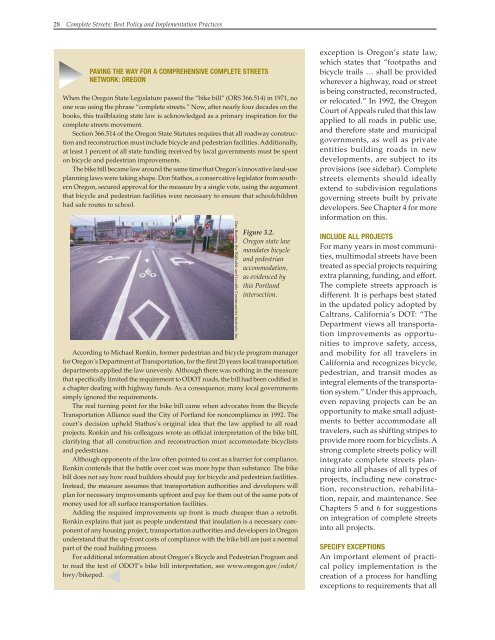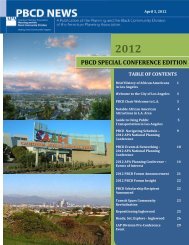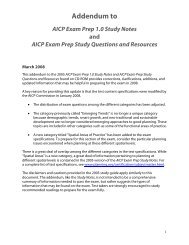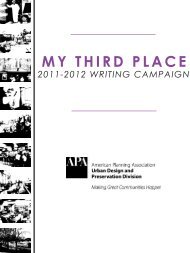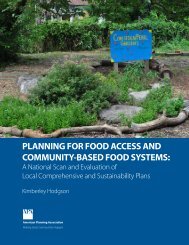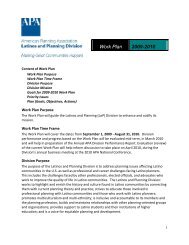Complete Streets: - American Planning Association
Complete Streets: - American Planning Association
Complete Streets: - American Planning Association
Create successful ePaper yourself
Turn your PDF publications into a flip-book with our unique Google optimized e-Paper software.
28 <strong>Complete</strong> <strong>Streets</strong>: Best Policy and Implementation Practices<br />
s According<br />
PAVINg ThE WAy FOR A COmPREhENSIVE COmPLETE STREETS<br />
NETWORK: OREgON<br />
When the Oregon State Legislature passed the “bike bill” (ORS 366.514) in 1971, no<br />
one was using the phrase “complete streets.” Now, after nearly four decades on the<br />
books, this trailblazing state law is acknowledged as a primary inspiration for the<br />
complete streets movement.<br />
Section 366.514 of the Oregon State Statutes requires that all roadway construction<br />
and reconstruction must include bicycle and pedestrian facilities. Additionally,<br />
at least 1 percent of all state funding received by local governments must be spent<br />
on bicycle and pedestrian improvements.<br />
The bike bill became law around the same time that Oregon’s innovative land-use<br />
planning laws were taking shape. Don Stathos, a conservative legislator from southern<br />
Oregon, secured approval for the measure by a single vote, using the argument<br />
that bicycle and pedestrian facilities were necessary to ensure that schoolchildren<br />
had safe routes to school.<br />
to Michael Ronkin, former pedestrian and bicycle program manager<br />
for Oregon’s Department of Transportation, for the first 20 years local transportation<br />
departments applied the law unevenly. Although there was nothing in the measure<br />
that specifically limited the requirement to ODOT roads, the bill had been codified in<br />
a chapter dealing with highway funds. As a consequence, many local governments<br />
simply ignored the requirements.<br />
The real turning point for the bike bill came when advocates from the Bicycle<br />
Transportation Alliance sued the City of Portland for noncompliance in 1992. The<br />
court’s decision upheld Stathos’s original idea that the law applied to all road<br />
projects. Ronkin and his colleagues wrote an official interpretation of the bike bill,<br />
clarifying that all construction and reconstruction must accommodate bicyclists<br />
and pedestrians.<br />
Although opponents of the law often pointed to cost as a barrier for compliance,<br />
Ronkin contends that the battle over cost was more hype than substance. The bike<br />
bill does not say how road builders should pay for bicycle and pedestrian facilities.<br />
Instead, the measure assumes that transportation authorities and developers will<br />
plan for necessary improvements upfront and pay for them out of the same pots of<br />
money used for all surface transportation facilities.<br />
Adding the required improvements up front is much cheaper than a retrofit.<br />
Ronkin explains that just as people understand that insulation is a necessary component<br />
of any housing project, transportation authorities and developers in Oregon<br />
understand that the up-front costs of compliance with the bike bill are just a normal<br />
part of the road building process.<br />
For additional information about Oregon’s Bicycle and Pedestrian Program and<br />
to read the text of ODOT’s bike bill interpretation, see www.oregon.gov/odot/<br />
hwy/bikeped.<br />
s<br />
Dan Burden, the Walkable and Livable Communities Institute, Inc.<br />
Figure 3.2.<br />
Oregon state law<br />
mandates bicycle<br />
and pedestrian<br />
accommodation,<br />
as evidenced by<br />
this Portland<br />
intersection.<br />
exception is Oregon’s state law,<br />
which states that “footpaths and<br />
bicycle trails … shall be provided<br />
wherever a highway, road or street<br />
is being constructed, reconstructed,<br />
or relocated.” In 1992, the Oregon<br />
Court of Appeals ruled that this law<br />
applied to all roads in public use,<br />
and therefore state and municipal<br />
governments, as well as private<br />
entities building roads in new<br />
developments, are subject to its<br />
provisions (see sidebar). <strong>Complete</strong><br />
streets elements should ideally<br />
extend to subdivision regulations<br />
governing streets built by private<br />
developers. See Chapter 4 for more<br />
information on this.<br />
INCLUDE ALL PROJECTS<br />
For many years in most communities,<br />
multimodal streets have been<br />
treated as special projects requiring<br />
extra planning, funding, and effort.<br />
The complete streets approach is<br />
different. It is perhaps best stated<br />
in the updated policy adopted by<br />
Caltrans, California’s DOT: “The<br />
Department views all transportation<br />
improvements as opportunities<br />
to improve safety, access,<br />
and mobility for all travelers in<br />
California and recognizes bicycle,<br />
pedestrian, and transit modes as<br />
integral elements of the transportation<br />
system.” Under this approach,<br />
even repaving projects can be an<br />
opportunity to make small adjustments<br />
to better accommodate all<br />
travelers, such as shifting stripes to<br />
provide more room for bicyclists. A<br />
strong complete streets policy will<br />
integrate complete streets planning<br />
into all phases of all types of<br />
projects, including new construction,<br />
reconstruction, rehabilitation,<br />
repair, and maintenance. See<br />
Chapters 5 and 6 for suggestions<br />
on integration of complete streets<br />
into all projects.<br />
SPECIFy EXCEPTIONS<br />
An important element of practical<br />
policy implementation is the<br />
creation of a process for handling<br />
exceptions to requirements that all


